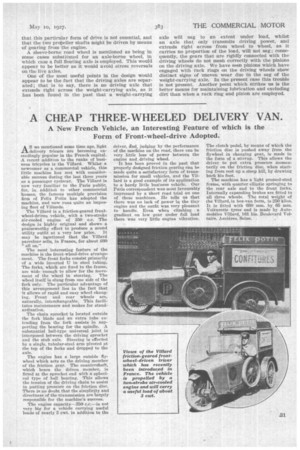A CHEAP THREE-WHEELED DELIVERY VAN.
Page 57

If you've noticed an error in this article please click here to report it so we can fix it.
A New French Vehicle, an Interesting Feature of which is the Form of Front-wheel-drive Adopted.
AS we mentioned some time ago, light delivery tricars are becoming exceedingly popular in the French capital. A recent addition to the ranks of business tricycles is the Villard. Whilst a newcomer as a commercial vehicle, this little machine has met with considerable success during the last three years as a passenger cycleear. The 'Willard is now very familiar to the Paris public, for, in addition to other commercial houses, the famous multiple provision firm of Felix Potin has adopted the machine, and now runs quite an imposing fleet of Villards.
The Villard is a friction-geared frontwheel-driven vehicle, with a two-stroke air-cooled engine of 350 c.c. The design is highly original and shows, a praiseworthy effort to produce a sound utility outfit at a very low price. It may be mentioned that the Villard parcelcar sells, in France, for about 160 "all on."
The most interesting feature of the machine is the front-wheel-drive arrangement. The front forks consist primarily of a wide inverted U in steel tubing. The forks, which are fixed to the frame, are wide enough to allow for the movement of the wheel in steering. The wheel itself is slung from one side of the fork only. The particular advantage of this arrangement lies in the fact that it allows of rapid and easy wheel changing. Front and rear wheels are, naturally, interchangeable. This facilitates maintenance and makes for standardization.
The chain sprocket is located outside the fork blade and an extra tube extending from the fork assists in supporting the bearing for the spindle. A substantial ball-type universal joint is interposed between the driving sprocket and the stub axle. Steering is effected by a single, tubular-steel arm pivoted at the top of the forks and dropped to the axle.
The engine has a large outside flywheel which acts as the driving member of the friction gear. The countershaft, which bears the driven member, is fitted at the sprocket end with a spherical type of ball bearing. This allows the tension of the driving chain to assist in putting pressure on the friction disc. There is no doubt that the simplicity and directness of the transmission are largely responsible for the machine's success.
The engine capacity-350 c.c.—is not very big for a vehicle carrying useful loads of nearly 3 cwt. in addition to the driver, And, judgiug by the performance of the machine on the road, there can be very little loss of power between the engine and driving wheel.
It has been proved in the past that properly designed friction gearing can be made quite a satisfactory form of transmission for small vehicles, and the Villard is a good example of its application to a hardy little business vehicle. Our Paris correspondent was most favourably impressed by a short road trial on one of these machines. He tells us that there was DO lack of power in the tiny engine and the outfit was very pleasant to handle. Even when climbing a gradient on low gear under full load there was very little engine vibration.
The clutch pedal, by means of which the friction disc is pushed away from the flywheel in changing gear, is made in the form of a stirrup. This allows the driver to put extra pressure momentarily an the friction disc, when starting from rest up a steep hill, by drawing back his foot.
The machine has a light pressed-steel frame, with quarter elliptic springing to the rear axle and to the front forks. Internally expanding brakes are fitted to all three wheels. The total weight of the Villard, in box-van form, is 250 kilos. It is fitted with 650 mm. by 65 mm. Voitnrette tyres and is made by Automobiles Willard, 161 bks. Boulevard Voltaire. Asni4res, Seine.




















































































































